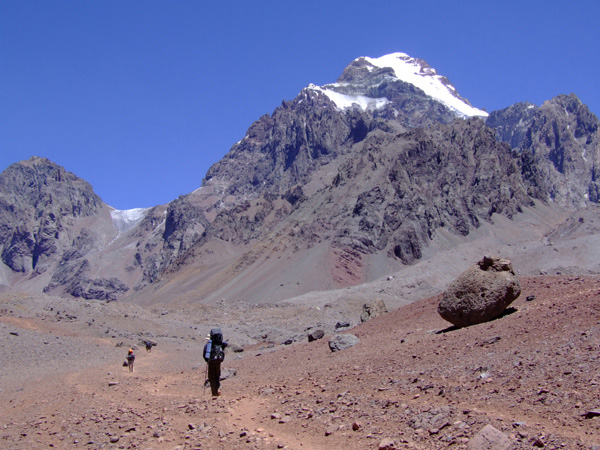Chile and Argentina
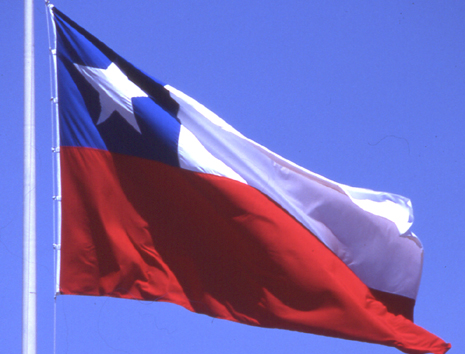

The Andes run north to south down the Chile-Argentina border for over 4000km. This page deals only with the high mountain areas in the north of these two countries, north of the capital cities at about 35ºS latitude. The southern areas are covered in the Patagonia Information page.
The Puna de Atacama
TREKKING AND CLIMBING
The Puna de Atacama is the name given to one of the worlds last great wildernesses, a high, windswept plateau that rises above the Atacama desert with scenery on a vast scale and cloudless skies. There are still many unclimbed high 5000m+ peaks in this area and a great deal of potential for anyone wanting to do some exploring on foot, by bike, by horse or by jeep. The highest peak in the Puna de Atacama is Ojos del Salado 6893m, the worlds highest volcano, closely followed by Pissis 6793m. Both of these peaks are very straightforward ascents, although the logistics of getting to them can be difficult and expensive. See our Puna de Atacama expedition options page for further details of the services we can run in this area.
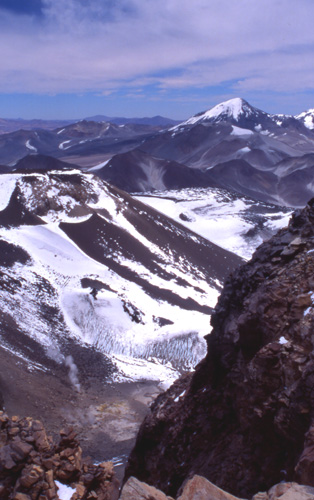 The peak of Tres Cruces from the summit of Ojos del Salado
The peak of Tres Cruces from the summit of Ojos del Salado
The Puna has only some really serious trekking and backpacking due to the high costs (and difficult logistics) of using mules in this area. It is however the best place in the world for what we call "high altitude hillwalking", with more big, easy mountains to climb than any other area of the Andes.
The peaks are so easy to ascend that many were climbed by native Indians around the time of the Inca empire (1500 AD), including Volcan Llullaillaco 6752m. On the summit of this remote mountain there are a couple of stone dwellings, and several sets of steps and altars - this is the worlds highest archaeological site. It is believed the Incans climbed the mountain to worship either the sun or the mountain itself, probably as a source of water. Llullaillaco is a very easy climb, although getting to the base of it involves a long 4x4 journey over remote desert tracks.
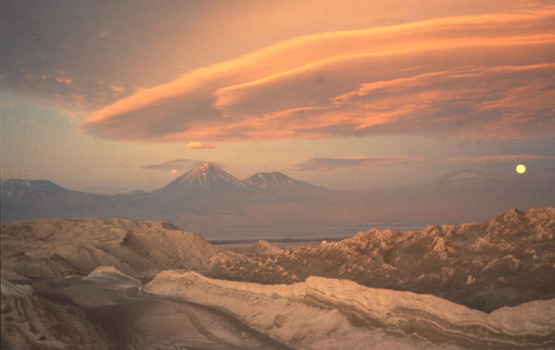
Volcan Licancabur at sunset
An easier mountain to reach is Volcan Licancabur 5930m. Licancabur is a beautiful cone which rises above the oasis village of San Pedro de Atacama. You can find a local guide here to arrange a trip to the mountain, but make sure you go for at least four days to give yourself time to get used to the high altitude. Other highlights of the Chilean Atacama area are a dawn trip to see the steaming Tatio geysers at 4500m and a jeep trip out over the huge salt flat of the Salar de Atacama to see the flamingos at the Laguna Chaxa.
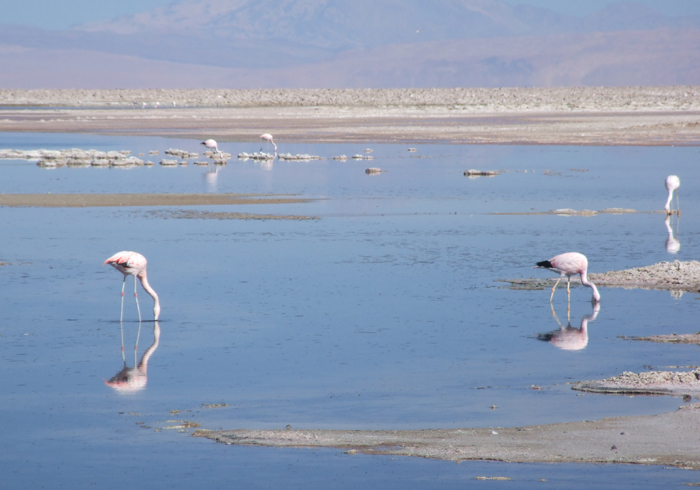
BIKING
There are some wild and challenging mountain bike routes through the Atacama with tracks reaching over 5000m. One of the best tours is a high level traverse of the Chilean Cordillera Occidental from the village of Parinacota, past the Salar de Surire salt flat to the deserted Andean village of Isluga. From here you have a 4500m descent to the Pacific Ocean at Iquique. On this tour you'll see vicuñas and flamingos, steaming volcanoes and hot springs. A mountain bike is essential due to the rough roads and you'll need to be self sufficient in food and camping gear. Allow about 8-10 days altogether.
This tour could be extended south to the area around Volcan Aucanquilcha 6176m an area which offers another unique mountain biking experience. On this and neighbouring peaks there are old mining tracks leading to 6000m. These can be descended on bike to give enormous downhill runs of up to 3000m. The problem is getting your bike up in the first place!!. The tracks are no longer passable to vehicles so you'll have to push in places. Further south again there is more good biking in the area around San Pedro de Atacama.
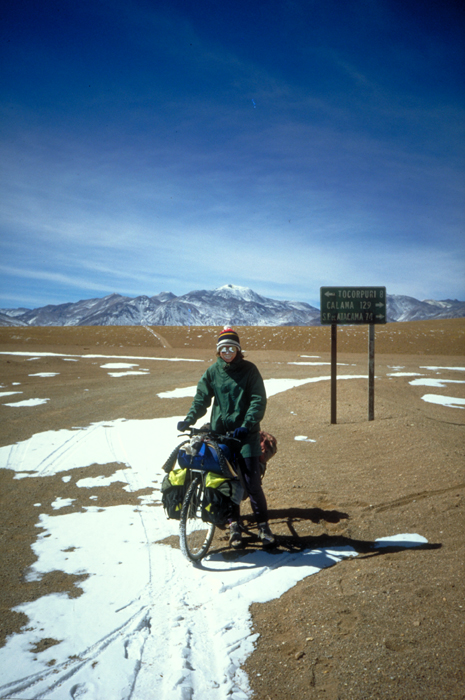

The valley of the moon near San Pedro de Atacama
Aconcagua Area
TREKKING AND CLIMBING
Aconcagua 6959m is the highest peak in the Andes. It is located entirely in Argentina near the large city of Mendoza. Because Aconcagua is an easy climb and the highest peak in the Americas, it is now the busiest mountain in South America. Permission is required to trek in the National Park that surrounds the mountain and also to climb Aconcagua. This is easy to arrange (but expensive to pay for) in Mendoza, a pleasant city only a few hours from the start of the trail.
The normal route on Aconcagua takes most people about two weeks, unless you have very good previous altitude acclimatisation. First there is a two day walk from Puente del Inca to the base camp at Plaza de Mulas at 4200m. From here the ascent is over scree with some snow patches and three or more higher camps will be needed before the final climb up the north-west ridge and a steep scree gully known as the canaleta.
If you aren't interested in climbing Aconcagua the two day trek to see the spectacular south face of this mountain is highly recommended. Follow the normal route to Confluencia then turn right to reach the Glaciar Horcones Inferior. A permit is still necessary, and not too cheap.
On the Chilean side of the mountains the small village of Baños Morales makes a good base for short walks and excursions. You can do many day walks from here that will take you up quiet Alpine valleys with views to the higher peaks. On the Argentine side of the mountains the ski resort of Vallecitos offers similar day walks, but there is no accommodation in summer.
Aconcagua from the east.
RAFTING
With big rivers and several big cities in the area it is no surprise that rafting is quite well developed in this area. The Rio Maipo on the Chilean side of the Andes is a popular descent as is the Rio Mendoza on the Argentine side.
SKIING
This central part of Chile and Argentina is the best place in South America to come for an exotic skiing holiday. Remember that the seasons are reversed and the best snow is found in July-September. The best resorts on the Chilean side of the Andes are Portillo, Valle Nevado and La Parva/Colorado. These three are modern purpose built resorts with hotels, 10-15 lifts each and up to 1000m of descents. It is also possible to ski all three of these resorts as day trips from Santiago. On the Argentine side of the Andes there is an international standard resort at Las Leñas 500km south of Mendoza and smaller resorts at Vallecitos and Penitentes just outside the city.
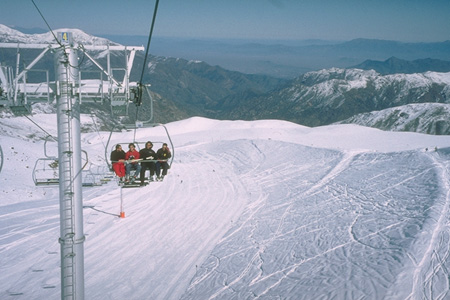
See our Ski information pages for more details.
Argentina and Chile Factfile
When to go - The summer months of December to February are best, but in the northern Puna activities are possible all year except in the midwinter months of July-September. Go skiing from July to September
Weather - The weather is generally very stable, but the high altitudes mean it can be very cold. Aconcagua and the Puna de Atacama get a lot of strong winds.
Flights - For the Aconcagua area fly to Santiago or Mendoza (via Buenos Aires) at a cost of about £900-£1000 from London. For the Puna de Atacama fly to either Copiapo or Calama in Chile or Catamarca in Argentina (about £1200 total)
Guidebooks - 'The Andes - A Guide for Climbers and Skiers' by John Biggar describes several routes on Aconcagua, all the easy peaks in the Puna de Atacama and easy volcano ascents throughout this area.

